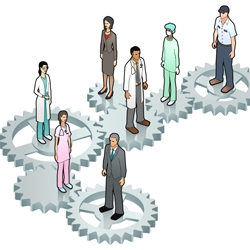 Effecting change in the NHS as a junior doctor can be a daunting experience. With limited power, influence and time it can seem an almost impossible task.
Effecting change in the NHS as a junior doctor can be a daunting experience. With limited power, influence and time it can seem an almost impossible task.
Yet, as a junior doctor we get a unique insight into how we can improve patient care. In this article The Network’s Rob Bethune offers a few helpful suggestions that can help facilitate change.
WHAT IS QUALITY?
A lthough ‘quality’ is discussed widely in many professions and industries, (the word is included some 360 times in Lord Darzi’s much cited NHS Next Stage Review Final Report1), it remains a slightly evasive concept.
The focus on quality has been apparent in healthcare for much of the 20th century and is both political (used by different professions to advance their particular interests) and subjective (dependent on who is assessing it and what values and consensus are used).
The popular definition of quality in healthcare that now dominates was produced by the Institute of Medicine and Committee on Quality Health Care in America (2001); this portrays safety, effectiveness, patient-centeredness, timeliness, efficiency and equity as the six ‘pillars’ of quality in healthcare.
Simply evaluating quality represents just one end of the quality continuum which includes quality assurance, and quality improvement. The latter, popularised by a number of quality improvement evangelists in the late 20th century (such as W.E. Deming and Philip Crosby), had its roots in managerial and industrial sectors before being applied to healthcare.
Perspective is also important: a key distinction is that between patient quality and professional quality. In the former, the patients’ perception of a service could be deduced by counting complaints, or rating service attributes for example. When professional quality is considered, the professionally assessed needs of patients represent the standard which should be met.
So, whether you are trying to measure it, assure it, or improve it, quality in healthcare is a slippery but increasingly relevant force for improvement.
ESTABLISH A TEAM
This is crucial, you cannot do it alone. Most of us do four or six month placements and this is often not enough time to run a project. Get a team of 6-10 people who can rotate whilst running the project throughout the year and you’ll find things much easier.
You’ll need as many pairs of hands as possible as good data collection is crucial and you need to make this easy and feasible for yourself. You can often get by with a little help from your friends but working in a team also makes it fun and gives you immediate motivation as your colleagues and friends will hold you to account.
DEVELOP A STRUCTURE TO THE PROJECT
It is useful from the outset of the project to set specific targets. This will help focus your mind and enable everything to be done by the end of the year.
The collaborative feature of this timeline is particularly important. If there are other groups in your hospital running quality improvement projects then make sure you have collaborative sessions with them. This will help all of you to learn from each other as well as providing motivation and support.
THE MODEL FOR IMPROVEMENT
There are a multitude of tools for improving quality of systems (Lean and Six Sigma are examples) but the most tried and tested model for healthcare is The Model for Improvement. I will describe it in more detail below using a current F1 quality improvement project as an example, but the diagram below shows the outline – make your aim, measure the thing you are trying to improve and then run a series of tests of change (the plan-do-study-act cycle).
AIM
What is it you want to improve? It is really important to carefully define this at the start to help you develop a deeper and more profound understanding of the system. Our example project was trying to improve the effectiveness of weekend handover. They wanted 95% of jobs that were handed over to the weekend team to be completed by Monday morning.
MEASURE
‘Data, data, data’ goes the drumbeat of a quality improvement project. Without it you will not be able to see if your changes are an improvement – but more importantly by getting really good data you will develop profound knowledge that will allow you really see what needs changing.
Profound knowledge is often underestimated. We see problems on the surface and think solutions are obvious and often we just go ahead and implement them. These simple change efforts are often unsuccessful because we do not really understand the system we are dealing with.
Once we have this knowledge then the changes are usually clear. Remember H.L. Mecken’s words ‘For every problem there is a solution, simple, elegant – and wrong’.
(WHILST WORKING FULL TIME AS A JUNIOR DOCTOR)
We have to be able to show that our solutions do make a difference so we plot our data on a run chart. In our example project the team collected data on how many jobs were being completed on a weekend (they sampled this data) and plotted the initial data before any tests of change on the graph below. As you can see they did this on five separate occasions to ensure the accuracy of their data.
THE PLAN-DO-STUDY-ACT-CYCLE (PDSA)
Now you have your background data collection and a deeper and more profound understanding of the system (weekend handover in our case) you are ready to make some changes. These are done in the form of a PDSA cycle.
The PDSA cycle is as simple and intuitive as it sounds; come up with a plan, trial it out on one day, study the effect and act upon the result. One of the keys is to trial the change over a short time period in one area. If it works you can spread it but if it doesn’t and needs refining then you can do that easily.
If you implement your idea widely from the beginning (as we have seen so often in healthcare!) and you get it wrong it is expensive both in terms of time and resources to undo it. Make your first tests small.
In our example (see the next run chart below) they did several PDSA cycles, improving the handover sticker in the notes as well as unifying the Excel spreadsheets used to pass the information on.
Through a series of small scale changes with continuous data collection the effectiveness of weekend handover increased dramatically (and for the managers out there – this was free!).
Improving the systems in which we work is crucial to improving the care we give to our patients. As junior doctors we are in a unique position to see the problems and affect the solutions.
ROB BETHUNE, SURGICAL REGISTRAR, SEVERN DEANERY
ACKNOWLEDGEMENTS. IZZY MARK AND JOANNE HOOKER AND THE REST OF THE WEEKEND HANDOVER GROUP AT NORT H BRISTOL NHS TRUST, FOR THEIR DATA .



